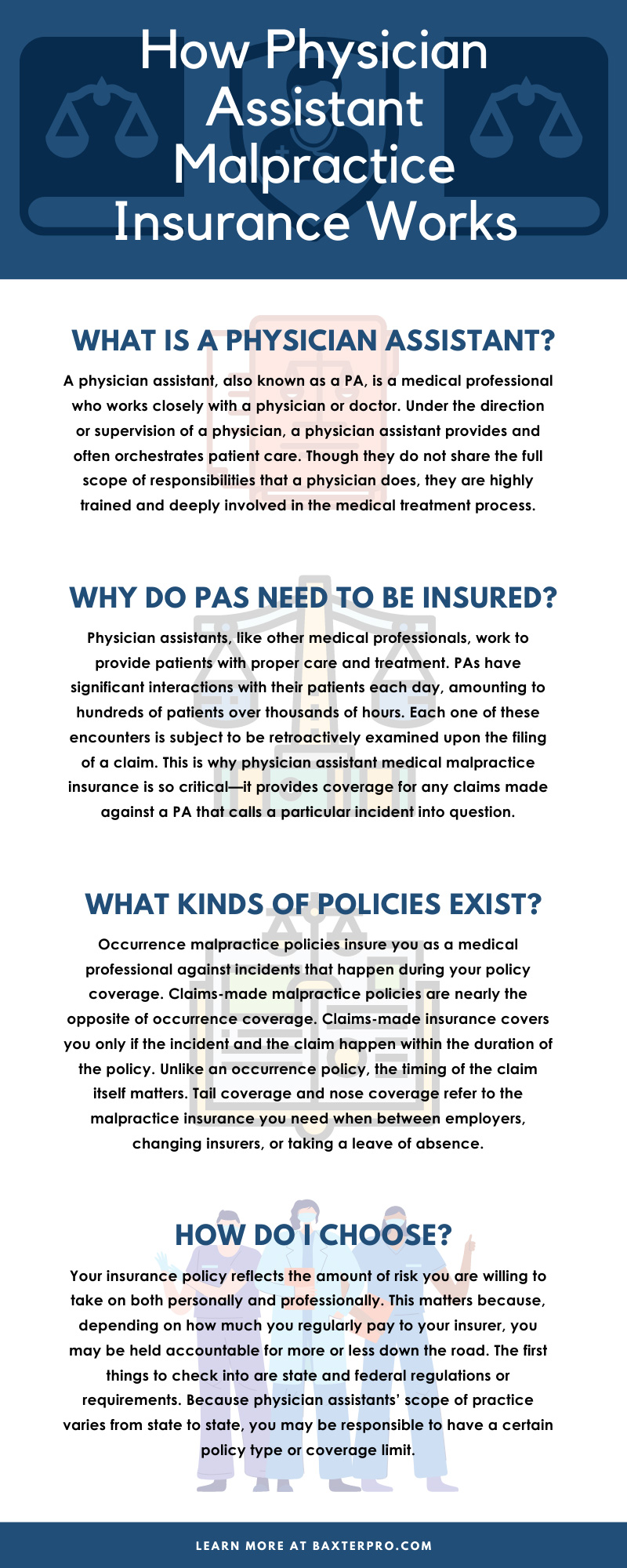
How Physician Assistant Malpractice Insurance Works
Oct 01 2020The world of insurance can be nebulous and frustrating, especially when you need simplified information fast. As a medical professional, you’ll find particularities in insurance policies that you need to grasp when setting up a contract. Here is a quick guide on how physician assistant malpractice insurance works.
What Is a Physician Assistant?
A physician assistant, also known as a PA, is a medical professional who works closely with a physician or doctor. Under the direction or supervision of a physician, a physician assistant provides and often orchestrates patient care. Though they do not share the full scope of responsibilities that a physician does, they are highly trained and deeply involved in the medical treatment process.
In the United States, the scope of a physician assistant’s practice varies by state. However, it is often the case that PAs are able to work quite independently. Their part in the treatment process includes collecting patient medical histories, performing certain physical exams, ordering and interpreting tests, diagnosing injuries and illnesses, and prescribing medications. Many PAs have their own independent practices, though this does depend on where a physician assistant practices medicine. Altogether, physician assistants are a critical part of the medical field and interact directly with patients. Because of this, they need to be covered by the right insurance.
Why Do PAs Need To Be Insured?
Physician assistants, like other medical professionals, work to provide patients with proper care and treatment. PAs have significant interactions with their patients each day, amounting to hundreds of patients over thousands of hours. Each one of these encounters is subject to be retroactively examined upon the filing of a claim. This is why physician assistant medical malpractice insurance is so critical—it provides coverage for any claims made against a PA that calls a particular incident into question.
Though the majority of physician assistants—and all other types of medical workers, for that matter—work tirelessly to provide quality care, there are times when something goes wrong. It is best to have the coverage you need when these scenarios arise. If you receive a claim and do not have insurance, you could be looking at immense amounts of money and paperwork to handle it on your own.
What Kinds of Policies Exist?
The amount of coverage you want will determine the type of policy you choose. Understanding the different kinds of medical malpractice insurance can be complicated, but it ultimately boils down to the timing of the claim and the policy. The three main types you need to know about are occurrence, claims-made, and tail or nose coverage.
Occurrence malpractice policies insure you as a medical professional against incidents that happen during your policy coverage. Regardless of when the claim itself is made, if the incident in question occurred while you were paying for and under the coverage of your policy, you are insured. For example, an incident occurs in October of 2019, and you were paying for an occurrence policy at that time. However, your policy ends at the conclusion of 2019, and a claim is made in February of 2020 regarding that incident. You are not currently paying for that insurance coverage, but because the incident happened while you were covered, the policy holds. The logic behind this insurance type hinges on the reality that claims often take time to process, and months can pass between something happening and a claim being made concerning it.
Claims-made malpractice policies are nearly the opposite of occurrence coverage. Claims-made insurance covers you only if the incident and the claim happen within the duration of the policy. Unlike an occurrence policy, the timing of the claim itself matters. Take the previous example. Though you paid for your policy at the time of the incident, you were no longer under the policy when the claim was made. Therefore, with a claims-made policy, you would not be covered for that claim. Despite many medical professionals preferring occurrence policies, claims-made coverage is often cheaper and more widely available. It is also required for practicing medicine in several states.
Tail coverage and nose coverage refer to the malpractice insurance you need when between employers, changing insurers, or taking a leave of absence. Though it is not a long-term policy like the primary insurance options of occurrence and claims-made, this malpractice insurance type is important to understand. When in any of these transition scenarios, you are technically without formal coverage. Depending on the policy you have, this could be a precarious situation if a claim is made during that time. Tail or nose coverage is an addition you can make to your current or upcoming policy that protects you when in the interim. Tail coverage can be added on to the end of your current policy to supplement your protection. Conversely, nose coverage (also known as retroactive coverage or prior acts coverage) can be chosen from your new insurance carrier to ensure claims that happen prior to the official start date of your new policy do not go uncovered. Typically, nose coverage is less expensive than tail coverage, but you may need to take advantage of one or the other at some point in your career.
How Do I Choose?
Your insurance policy reflects the amount of risk you are willing to take on both personally and professionally. This matters because, depending on how much you regularly pay to your insurer, you may be held accountable for more or less down the road. That’s why there are several essential tips for choosing physician assistant liability insurance. The first things to check into are state and federal regulations or requirements. Because physician assistants’ scope of practice varies from state to state, you may be responsible to have a certain policy type or coverage limit. Also, ask other local PAs and see what options they have chosen. You may be able to receive some sound advice from medical professionals who have gone through the selection process. For the most accurate and up-to-date insurance information, reach out to an insurance professional like the ones on our team here at Baxter and Associates LLC.
This guide on how physician assistant malpractice insurance works provides you with the basics you need to set up a policy. If you want more information or are looking to purchase a physician assistant malpractice policy, contact one of our insurance professionals at Baxter and Associates LLC today!




